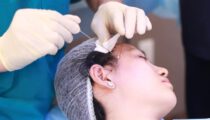Is Brown spots on the skin a form of melasma? Safe removal methods
The article is consulted by Dr. Phạm Thu Phương, a dermatologist currently working at Mega Gangnam International Clinic.
When unusual brown spots on the skin, it can undoubtedly cause concern as to whether it is melasma or caused by some other medical condition. This article by Mega Gangnam aims to clarify the factors leading to the appearance of brown spots on the face and safe methods for their removal.
What exactly are brown spots on the skin?
Brown spots on the skin are actually melanotic pigments, according to Dr. Phạm Thu Phương, a specialized dermatologist at Mega Gangnam International Clinic. These spots, with various shades of brown ranging from light to dark, typically appear on the face after the age of 25. This is considered a relatively normal dermatological condition and is mainly attributed to melanocytes, a type of cell that increases melanin production beneath the skin’s surface.

The presence of brown spots on the face is an indication of increased melanin pigmentation beneath the skin
Brown spots can increase in number and affect different areas of the skin if you are exposed to a lot of sunlight. At various ages, from the elderly to both men and women, individuals may experience brown spots on the skin. Of course, there is generally no need to be overly concerned about this, as most brown spots that appear are not related to any underlying health conditions.
However, in some cases, unusual skin may experience the appearance of brown spots due to internal health issues, including cancer. In general, with cases of abnormal health conditions affecting both internal health and appearance, it is advisable to consult dermatologists or visit healthcare facilities for a thorough examination.
In reality, are brown spots on the skin melasma?
If observed with the naked eye, many women are likely to mistake brown spots on the skin for melasma. This is because their characteristics bear similarities to the dark and aesthetically displeasing appearance of melasma. Dr. Pham Thu Phuong explains that brown spots and melasma are two independent dermatological conditions.
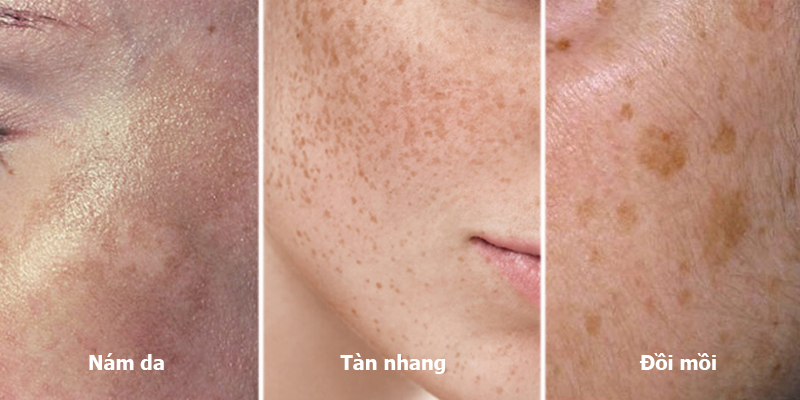
Different shades of brown spots on the face
You can differentiate between the two conditions of brown spots on the skin and melasma based on the following hints:
- Brown spots: They will appear randomly on any part of the body, such as the face, neck, arms, back, abdomen, etc., and of course, they are not arranged in any specific order. The size of these spots is generally small.
- Melasma: Melasma typically appears mainly on facial skin areas, such as the forehead, cheeks, chin, and tends to develop over a broad area over time. Moreover, melasma often grows symmetrically, such as on both sides of the cheekbones. Melasma may have colors other than brown; it can exhibit shades of green, reddish-brown, or even black.
- Freckles: Freckles are also small brown spots on the skin, usually found in areas frequently exposed to sunlight.
Causes of Brown Spots on the Face
Brown spots or melasma and freckles share some common factors that contribute to their appearance:
Hormonal changes
Estrogen is one of the hormones capable of inhibiting melanin. For women entering pregnancy, postpartum, or perimenopause, hormonal changes occur, and a decrease in estrogen levels leads to increased melanin production. Over time, this accumulation results in the formation of brown spots on the skin.

Changes inside the body lead to external signs such as the appearance of brown spots
Sunlight and Increased Melanin Production
Sunlight always has a detrimental effect on the skin and is the leading common cause of brown spots on the face. Normally, melanin, the pigment responsible for skin color, is produced to protect the skin from the harmful effects of sunlight. However, excessive and frequent exposure can lead to a sudden increase in melanin production. Instead of being expelled, melanin accumulates and forms brown spots, melasma, and freckles.
Effect of Aging
As age advances, brown spots tend to appear more frequently, and you may notice them on your hands. For women aged 30 and above, the skin faces the risk of pigmentation issues, causing premature aging and skin weakening.
Occupational Impact
Certain occupations involving exposure to an unsafe environment, such as prolonged sunlight exposure or contact with chemicals, can increase the risk of skin problems. People engaged in gardening, baking, or industrial work may be more prone to these issues.
Skin Cancer
- Basal Cell Carcinoma: It may manifest as brown spots, often mistaken for moles. Patients often seek treatment related to moles when dealing with basal cell carcinoma at Central Dermatology Hospital.
- Squamous Cell Carcinoma (Scale Cell Skin Cancer): Lesions, scars, chronic inflammation can develop into tumors over time.
- Melanoma: This is a malignant skin cancer type, with up to 70% of deaths related to melanoma. Early symptoms usually include dark, brown spots on the palms, soles, fingers, toes, or face.
Genetics
Genetic factors are also one of the reasons to consider if you notice brown spots on your skin. If your parents have issues like brown spots or freckles, there is a high chance that you may be susceptible because these pigmentation issues are often encoded in the structure of genes, making intervention and treatment challenging.
Other Causes
Other factors such as an inadequate diet, improper lifestyle, excessive use of cosmetics, and endocrine disorders like Addison’s disease can contribute to the appearance of brown spots.
A person may experience one or a combination of these issues. Without effective treatment solutions, pigmentation problems may worsen, affecting the aesthetic appeal of the skin and diminishing confidence.
Is there an effective treatment for skin with brown spots?
Treating skin with brown spots is not difficult, except for health-related issues such as skin cancer mentioned above, you can completely intervene with modern technologies for treatment and complete removal.
Mega Fiber White – Specialized treatment for pigmentation issues, brown spots, melasma, and freckles
Mega Fiber White is a technology specifically designed to treat melasma and pigmentation issues, evaluated by experts as one of the best currently available. This is a cellular regenerative super-technology that applies the exclusive research result Exosomes – a type of extracellular vesicle secreted by living cells in the body. They contain growth factors, lipids, and miRNA, with the function of effectively restoring and regenerating the skin. Thanks to the ability to resolve brown spots and melasma at multiple points, pigmented cells are completely removed.
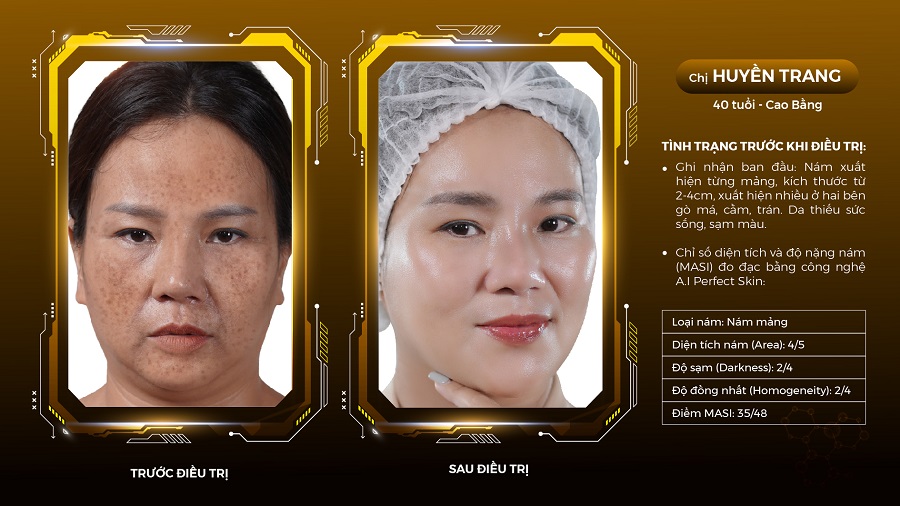
The effectiveness of the treatment after the Mega Fiber White course removes all pigmentation
The treatment regimen also incorporates the use of the number 1 Laser in the USA for surface pigmentation removal, breaking down melasma, and the anti-brown spot properties returning with Mega Melasma. It simultaneously brightens the skin, stimulates collagen production, and regenerates multilayered skin. The Mega Fiber White treatment is FDA certified as safe and does not cause damage to the skin. It is suitable for all skin types (including those with dilated blood vessels, those who have used mixed creams, or those with sensitive skin) and can be used at any time of the year.
Skin sanding treatment method
This technology uses specialized equipment to sand the skin area with brown spots. This friction process will remove the outer layer of the darkened skin. Additionally, the solution also supports natural collagen production for better skin regeneration. However, skin sanding can cause complications if the procedure and operations are not standardized. Please carefully consider the location to avoid skin surface infections or scarring.
Chemical peel to blur brown spots
Chemical peel, also known as bio-replacement, is a skin regeneration method to blur brown spots and quickly regenerate the skin surface. Chemical peel formulas often use low to high concentrations of chemical solutions – acids applied to the skin surface. Peel products will gently exfoliate the skin’s surface, creating conditions for new skin cells to develop, gradually fading dark marks and brown spots on the skin. However, this solution will not completely remove brown spots or melasma.
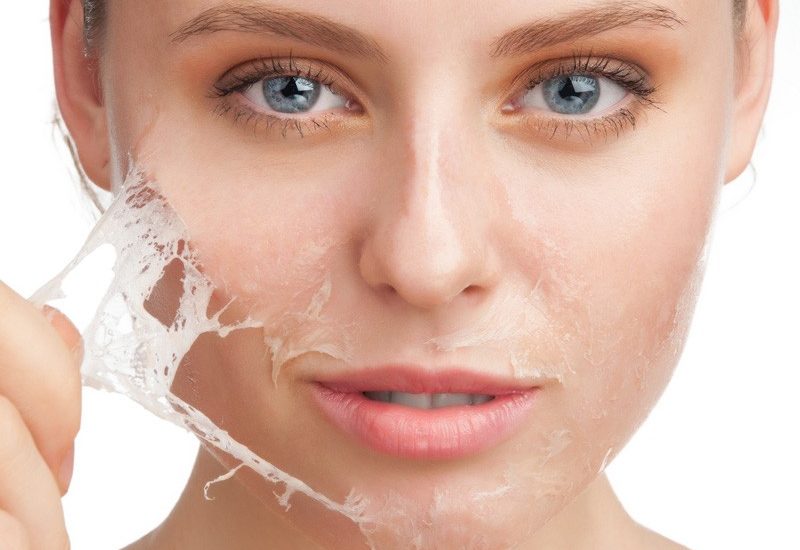
Chemical peels have a specific effect on uneven skin tones, but generally, the effectiveness is not high
Using specialized creams containing Hydroquinone
Hydroquinone is a common ingredient in skin brightening creams that inhibits the release of melanin, causing brown spots. Products containing therapeutic agents often have Hydroquinone concentrations of 3-4%. With higher concentrations, you should use them according to the instructions of a specialist doctor and consider the dosage to avoid side effects.
Laser treatment for brown spots
Laser technology is widely applied in various skin treatments, especially for brown spots, melasma, and freckles. Among them, the most common treatment is long-pulse laser, which gently breaks down pigments without causing burns or skin irritation. Laser therapy also helps quickly eliminate brown spots and supports the treatment of other pigmentation issues.
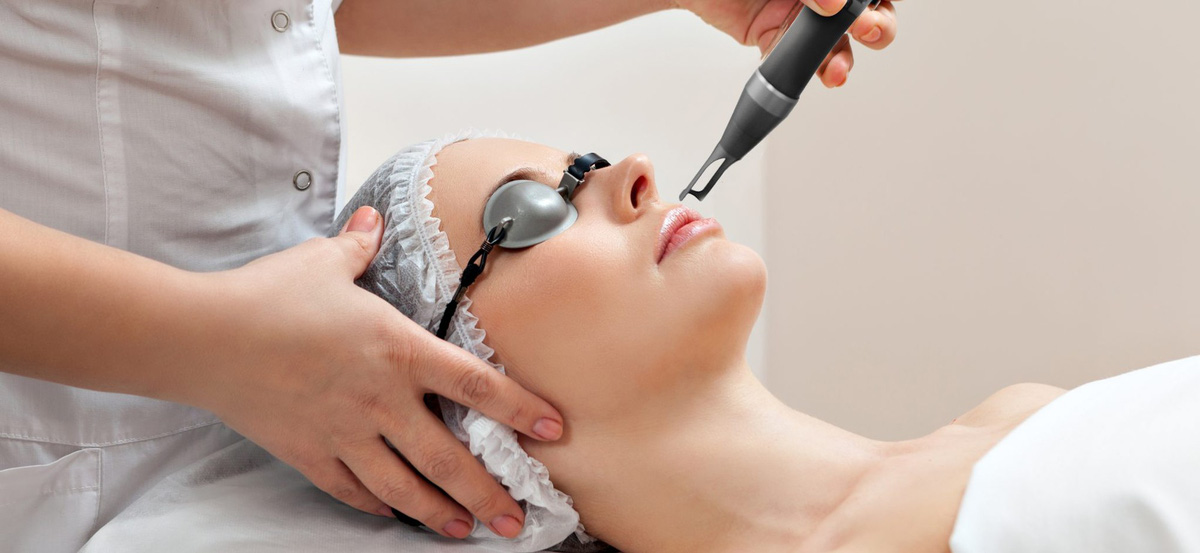
Laser is a quite popular method in treating pigmentation on the skin
Using vitamin E to lighten brown spots
Vitamin E supplements contain antioxidants and anti-inflammatory properties that can effectively help fade blemishes on the skin. Apply vitamin E to the skin for a few hours each time, consistently over a period of time to improve discolored areas. Vitamin E also supports natural skin rejuvenation.

Mega Gangnam is a reputable address for treating dermatological conditions and pigmentation
Mega Gangnam is a reputable specialized facility with over 15 years of operation, boasting a team of highly skilled doctors, including Dr. Bui Thi An, Dr. Pham Thu Phuong, Dr. Tran Anh Duc, and foreign experts from South Korea, such as Lee Kill Sun and Dr. Kim Ji Yeon. They are dedicated to providing comprehensive solutions for brown spot issues.
Furthermore, Mega Gangnam’s examination and treatment procedures adhere to medical standards, ensuring attentive care to offer customers the best experience. Contact 093 770 6666 for consultation and answers to any questions about skin discoloration or the treatment of brown spots on the cheeks or the entire face today!







